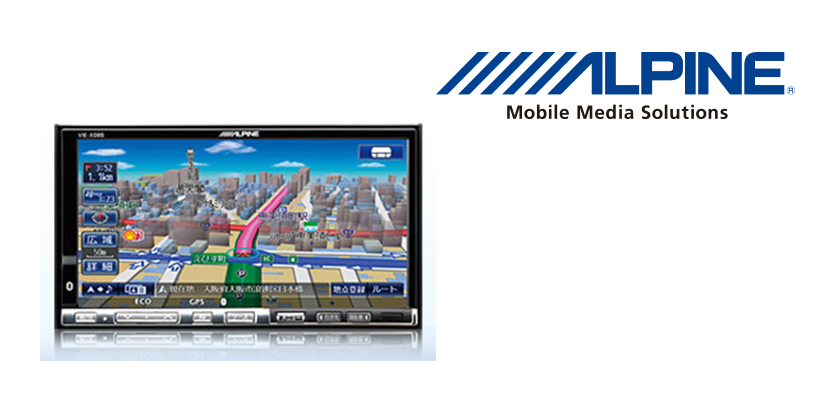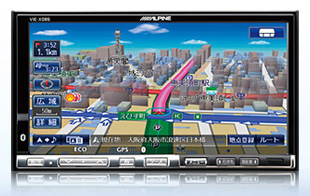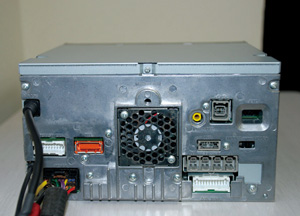Alpine Electronics, Inc.

Successful Implementation of Thermo-Fluid Analysis in Car Navigation System Design
Alpine Electronics, Inc. (hereinafter, Alpine) is an electronics development company specialized in automotive systems such as car navigation systems and car audios. Alpine design engineers are utilizing thermo-fluid analysis tool in the design of car navigation systems. Ten years after the introduction of a Computational Fluid Dynamics (CFD) tool into Alpine, it is well-established as a familiar tool for thermal analyses, and thermal simulations are performed at early stages of development, as early as preliminary discussions with car manufacturers. We interviewed an Alpine staff about how they accomplished the great achievement.
Alpine develops automotive systems such as car audio systems and dashboard information communication equipment. Alpine has headquarters in Tokyo, a development center in Fukushima. Sales bases, manufacturing bases, and development bases are also located overseas and diversify geographically. A high proportion of its products is genuine automotive products. Especially, car audio has a high standing among users who are particular about sound quality. Also, Alpine BIGX (VIE-X088 or VIE-X08S) 8-inch car navigation system (Fig.1) has gained a high reputation, and this has led to a good sale.

Fig.1: ALPINE BIGX (VIE-X088) 8-inch car navigation system
Introduction of CFD tool in 2001
In 2001, Alpine introduced a thermo-fluid analysis tool "HEAT Designer" developed by Software Cradle to the Car Navigation System Development Department. The company introduced the thermal analysis tool because of high maximum safe operating temperature. Unlike home electronics, in-car devices are placed in extreme environments such as direct sunlight. Because the maximum safe operating temperature of these devices is tens of degrees (ºC) higher than that of home appliances, the introduction of thermal analysis tool was crucial. Since most design engineers were unfamiliar with software operations, HEAT Designer was chosen for its operability and comprehensible GUI.
They started using the thermo-fluid analysis tool on a full scale from around 2004. Ms. Machiko Iwasaki, an engineer from Structural Product Development Department and responsible for heat dissipation designs, has worked consistently on spreading the use of the tool among design engineers.

ALPINE JSME-Certified Computational Mechanics Engineer
Machiko Iwasaki
Improving the CFD education environments
In order to expand the thermo-fluid analysis tool to Alpine design engineers in her department, she established the education system and the environment to allow easy use of the analysis tool. Ms. Iwasaki started launching the group education program with Software Cradle, prepared a dedicated text for Alpine from around 2005 based on several goals she set for the educational program. The education system should be practical, immediately applicable to design sites, easy to remember, and it should encourage continuous skill improvements based on the design concepts. To meet her goals, Cradle provided information needed for Alpine and used Alpine products for the model cases. The text included theories so that the engineers could make full use of the analysis tool based on the fundamentals of thermo-fluid dynamics. After a series of discussions between her and Cradle engineers about the text and lecture contents, the text includes fundamentals of thermo-fluid dynamics, analytical theory, operation procedures for analysis preparation and analysis results display, and heat dissipation design concepts in Alpine. She included concrete operation procedures in a text so that the participants can perform analyses themselves after the course.
The group education program was carried out with up to eight people taking a lecture course for three days. The final exam on the thermal problem of an actual product was given out on the last day of the course, and the due date was scheduled one week from the final exam. This one week period would help establish the education content by getting participants to learn through trial and error. And the course was held about twice a year. Today, almost all employees involved in thermal design in the Structural Product Development Department are trained in the course and utilizing the tool in practice. Some members of affiliated companies or technology center in China also came to attend this program. Later, the text was translated for the training of Chinese design engineers about HEAT Designer.
After each program, participants were asked to fill out an evaluation form which is rated on a five-point scale. The average rating on the first course was 3.6, but it rose to 4.7 on the most recent course. Ms. Iwasaki says, "we were able to build the base part of the thermal design concept for Alpine by receiving advice from Software Cradle while refining the program."
Facilitating accessibility to the analysis tool
Ms. Iwasaki improved the environment for the analysis tool. Specifically, she prepared a dedicated interface to facilitate analysis work and organized the database system to store data such as analysis results, measured temperature of the actual products, and reports. She also prepared a display system for non-CFD experts to understand the analysis results easily. Furthermore, she created a system to store and retrieve analysis data and exchange it between circuit design and mechanism design smoothly.
The web-based CAE integrated tool (CAE-ONE) is used for interface and database (provided by Information Services International-Dentsu, Ltd). An easy-to-use interface was required in calculations because they used parallel computation (HPC) edition of scSTREAM, a high-end sister product of HEAT Designer, on a Linux cluster server that had no GUI. This motivated the introduction of CAE-ONE to Alpine. If a user registers a data file necessary for analysis to the CAE-ONE, it is sent to the parallel computation system. After the computation, the results are stored in the CAE-ONE, and the notification mail is sent to the user. CAE-ONE also has a function of database storing not only the results of thermo-fluid analyses but also the data from various other analyses in the department. Moreover,data of measurements on the actual products and reports are managed using CAE-ONE.
Presenting analysis results in easily comprehensible ways
Since it is hard for non-CFD experts to understand analysis results if they are just series of numbers, Alpine uses Excel macro to provide an easy view of analysis results, so that the display can show significant values and graphs (convergence status of calculations, fan motor operating points, temperature of each part, heat fluxes, etc.) with one push of a button.
Because errors tend to occur when sharing information across departments, data must be handled with care. In Alpine, electrical design engineers transfer IDF files (intermediate files of electrical CAD) and CSV files containing thermal analysis conditions, to mechanism design engineers. The system is designed to check the data in Excel automatically, then the data is transferred to mechanism design engineers. The system works smoothly as HEAT Designer read data in CSV format.
Holding upgrade seminars and skill sessions with the developers
When HEAT Designer was upgraded, For the upgrading of HEAT Designer, Ms. Iwasaki examines the accuracy of the software and checks whether the new features can be applied to analyses in her department. Then, in cooperation with Software Cradle, she upgrades the rules to use the analysis tools, modifies the system, and receives the texts for training courses. In the 2009 upgrade, multiblock function was the major upgrade. The function makes meshes dense in a specified area, reduces the number of mesh elements, and improves the calculation convergence. This function helped Alpine reduce the analysis time by 60%.
When HEAT Designer was upgraded, design team representatives attended the seminars, learned new features, and exchanged opinions with Cradle engineers in skill sessions. Ms Iwasaki says, "To meet with software developers is a valuable opportunity, it helps design engineers understand and utilize the tool effectively."
Improving analysis accuracy and enhancing library data
Improving analysis accuracy is one of the destined themes for someone trying to spread an analysis tool. Alpine conducts own research on input information such as material properties necessary for an analysis and shares it among the design engineers. Especially, characteristics of fan motors significantly affect the analysis accuracy. Alpine introduced a fractional flow rate measurement system manufactured by Tsukuba Rika Seiki Co., Ltd., and created a library of fan motor characteristics. The system enables them to accurately understand fan motors' characteristics varying depending on usage (Fig.2). This created an environment where accurate input information can be collected immediately, and greatly encouraged design engineers to use the analysis tool.

Fig.2: VIE-X08S (back side) Protective cover is on the motor fan.
Contributions to decreasing thermal problems / Impact on cost reduction
As a result of Ms. Iwasaki's efforts, CFD analysis is firmly established and applied to all products in her department. The analysis is used from the stage of preliminary discussions with their clients worrying about heat and noise through fans. For heat generation, a wire harness wired along a car navigation system has an upper temperature limit so that the thermal analysis tool is used first to check the temperature is within the limit presented by their clients. This not only prevents production rework before mass production, but also allows design engineers to have a wild model change during the early stage of design to meet requested performance of a product.
The number of analyses performed in her department has grown to 2000 cases a year. Especially after they have started parametric studies for optimizing geometries, the number of analyses has grown by repeating computations with different parameters. Thanks to an optimization tool of Cybernet Systems; however, a series of operations is automated from CAD shape modification to postprocessing, their labor work is minimalized even though the number of analyses has grown. "In this automation processing, macro functions of HEAT Designer have been extremely useful," says Ms. Iwasaki.
In addition to optimizing products' performance, parametric studies reduce material cost. In recent years, there have been increased demands from automakers to develop lightweight products. Heat sinks tend to be the weight reduction target because they are chunks of aluminum. Heat sinks have an affinity to parametric studies and is studied frequently in Alpine with the analysis tool. Through parametric studies, both weights and material cost are reduced by 10- 20 % in average. Also, there was a case where one of the two fans in a chassis could be removed by optimizing air circulation and operation point of the fan. This was a great cost-cutter.
Reducing the labor and increasing the research time for designing
Work after an analysis is already organized for design engineers, so Ms. Iwasaki wants to cut the analysis preparation time by simplifying preparations before analysis. For many years, HEAT Designer has only been used in simulation-dedicated computers, but now she is considering changing the license option from "node-locked" to "floating" in parallel with enhanced computer performance. Although she hopes for the design engineers to work on analyses smoothly, design engineers have been busy especially in recent years. They can hardly make time to study heat dissipation mechanisms using HEAT Designer so that Ms. Iwasaki's group has been receiving lots of requests for simulations. She cannot help the change in the design engineers' circumstances moving with the times, but she wants to give design engineers time to research thermal designs by improving the usage environment of the analysis tool and reducing the operation time. It is a consistent goal that she has been working to reach, but she is aiming for an environment that encourages generations of new design ideas, not merely aiming for a user-friendly system with simple and automated operations.
Also, design engineers in her office started using new analysis functions such as Particle (dust) and Solidification/Melting analysis. These functions are in scSTREAM. She has not decided to use scSTREAM in her group yet, but she is planning to incorporate design methods applicable to HEAT Designer into the training program.
Ms. Iwasaki has succeeded in radicating thermo-fluid analysis tool in Alpine by establishing an environment for busy engineers to use tools effectively and accurately. The successful achievement of training projects in Alpine will be helpful for those companies considering introducing a new system or having a hard time of radicating one after the introduction.

Alpine Electronics, Inc.
- Date of Establishment: May. 10th, 1967
- Description of Business: In-car Audio Products/In-car Information & Communication Products
- President & CEO: Toru Usami
- Headquarters: Tokyo, Japan
- Paid-in Capital: ¥25,920 million
*All product and service names mentioned are registered trademarks or trademarks of their respective companies.
*Contents and specifications of products are as of March 1, 2011 and subject to change without notice. We shall not be held liable for any errors in figures and pictures, or any typographical errors.


